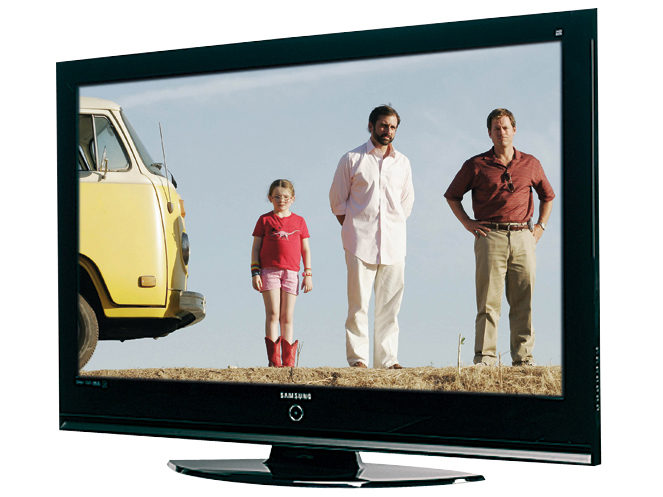TechRadar Verdict
A 50-inch plasma with a stunning design, great features and a performance that's a million times better than you'd expect
Pros
- +
Good, intense picture quality
Sensible design
Cons
- -
Noise can be exaggerated
Why you can trust TechRadar
It's not so very long ago since anyone suggesting you might one day get a 50-inch flat TV for under £3,000 would have been laughed out of the room.
Then, out of the blue, Samsung launched the impressive 50-inch PS-50Q7HD for just £2,300. And now the Korean giant is rocking the TV world again by releasing a revved up version of that groundbreaking set, called the PS-50P7HD, that can be yours for the even smaller amount of £1,800. But is this screen really the bargain it first appears?
If you could judge a book by its cover, the PS-507HD would be the best TV ever. With its ultra-minimalist, high-gloss black lines it really is a sight for sore eyes. It's probably sensible to start this section by detailing the differences between the 50P7HD and the previously reviewed 50Q7HD.
For starters, the P7 has two HDMIs versus its sibling's one. There's another improvement on the connections front, too, in that the P7 carries a 9-in-2 card slot system for direct playback of JPEG images from just about every multimedia storage card we can think of, as well as a USB port and even a PictBridge output for direct JPEG printing.
The 50P7HD also features a swivel stand where the Q7 doesn't; with the last big improvement concerning audio, as the P7 ups the audio output from twin 10W speakers to a pair that punch out 15W. Hopefully, this will sort out the rather flimsy sonics experienced from output on many of Samsung's recent flat TVs - and that even includes the 50Q7HD.
Other connection options include the inevitable component video input that's demanded by the HD Ready specification, a VGA PC input and two Scarts. The presence in the 50P7HD of a digital tuner also means we find both a Common Interface slot for adding subscription TV cards, plus a digital audio output for Dolby Digital 5.1 broadcasts.
Pretty as a picture
The 50P7HD boasts three potentially key picture improvement technologies. First up there's Samsung's new Smooth Motion Driver (SMD) system, which calculates and inserts as many as 10 extra frames of image per second to make onscreen movement more fluid.
Next there's FilterBright technology, which adds a filtering layer into the plasma panel to reduce the impact of onscreen reflections by up to 90 per cent - potentially radically increasing the TV's contrast in the process.
Last but not least, there's Samsung's Digital Natural Image (DNIe) engine video processing system, where fancy algorithms set about improving such elements of the picture as colour saturation and tone, contrast, fine detailing, and noise levels. Elsewhere you'll find a separate noise reduction system, picture-inpicture tools, anti-screen-burn measures, and a game mode, which optimises the picture (including reducing the response time) for console gaming.
It's difficult to see how Samsung could improve things much in this department. The remote control is as sensibly laid out as it is elegantly designed, and the onscreen menus are as logically structured as they are prettily presented. The pictures on the 50P7HD enjoy exactly the same technology as those of the 50Q7HD - so it's not exactly surprising to discover that they also perform precisely the same. Which is mostly - though not entirely - good news.
Probably the 50P7HD's greatest picture strength is the awesome intensity of its colours. Seldom, if ever, have we seen such vivid, full saturations on a plasma TV and this richness impressively holds as good for dark scenes as bright ones. The colour intensity can actually be a bit overwhelming unless you keep the colour setting below 50 per cent, but provided you're careful, the vibrancy really helps pictures look spectacularly dynamic.
Of course, such rich colours likely wouldn't occur if the TV didn't have a good black level response. And, in fact, the 50P7HD has a great one, achieving almost pitch blackness uninterrupted by the sort of green pixel noise still common on plasma TVs.The set handles motion pretty well too, even without the SMD activated, and there's precious little sign of plasma's problems with dotting noise over horizontal motion and colour striping.
And the bad news
On the downside, the first flaw is that high-definition pictures don't look quite as crisp as we know they can. Secondly, although black levels are deep, they lack some of the subtle shadow-detailing that's evident on the very best screens.
Thirdly, noise in a signal, especially MPEG noise via the HDMI input, can be exaggerated, especially if you're not sensible with the brightness settings. And finally, that colour richness can occasionally result in fleshtones looking a touch unnatural and waxy - especially while viewing standard definition.
The extra power afforded to the 50P7HD sadly doesn't pay as handsome a dividend as we hoped. Bass seems a little fuller and voices a bit more credible, but the soundstage still doesn't project and is unimmersive as on the 50Q7HD.
If you thought a good quality 50-inch flat TV was simply beyond your means, this extraordinarily cheap Samsung sets you straight in no uncertain terms.
Tech.co.uk was the former name of TechRadar.com. Its staff were at the forefront of the digital publishing revolution, and spearheaded the move to bring consumer technology journalism to its natural home – online. Many of the current TechRadar staff started life a Tech.co.uk staff writer, covering everything from the emerging smartphone market to the evolving market of personal computers. Think of it as the building blocks of the TechRadar you love today.
